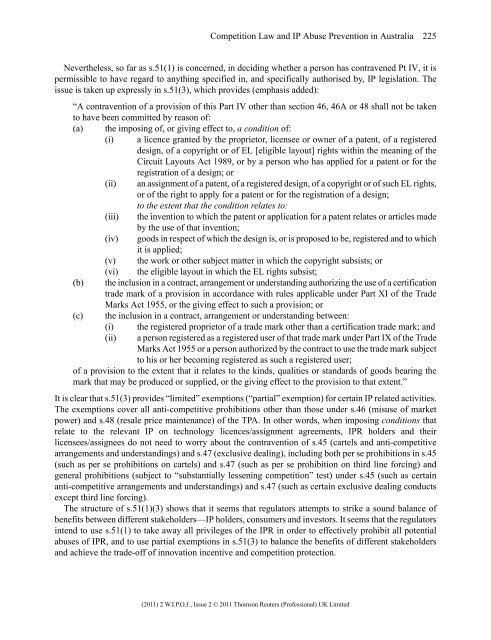WIPO Journal - World Intellectual Property Organization
WIPO Journal - World Intellectual Property Organization
WIPO Journal - World Intellectual Property Organization
You also want an ePaper? Increase the reach of your titles
YUMPU automatically turns print PDFs into web optimized ePapers that Google loves.
Nevertheless, so far as s.51(1) is concerned, in deciding whether a person has contravened Pt IV, it is<br />
permissible to have regard to anything specified in, and specifically authorised by, IP legislation. The<br />
issue is taken up expressly in s.51(3), which provides (emphasis added):<br />
“A contravention of a provision of this Part IV other than section 46, 46A or 48 shall not be taken<br />
to have been committed by reason of:<br />
(a) the imposing of, or giving effect to, a condition of:<br />
(i) a licence granted by the proprietor, licensee or owner of a patent, of a registered<br />
design, of a copyright or of EL [eligible layout] rights within the meaning of the<br />
Circuit Layouts Act 1989, or by a person who has applied for a patent or for the<br />
registration of a design; or<br />
(ii) an assignment of a patent, of a registered design, of a copyright or of such EL rights,<br />
or of the right to apply for a patent or for the registration of a design;<br />
to the extent that the condition relates to:<br />
(iii) the invention to which the patent or application for a patent relates or articles made<br />
by the use of that invention;<br />
(iv) goods in respect of which the design is, or is proposed to be, registered and to which<br />
it is applied;<br />
(v) the work or other subject matter in which the copyright subsists; or<br />
(vi) the eligible layout in which the EL rights subsist;<br />
(b) the inclusion in a contract, arrangement or understanding authorizing the use of a certification<br />
trade mark of a provision in accordance with rules applicable under Part XI of the Trade<br />
Marks Act 1955, or the giving effect to such a provision; or<br />
(c) the inclusion in a contract, arrangement or understanding between:<br />
(i)<br />
Competition Law and IP Abuse Prevention in Australia 225<br />
the registered proprietor of a trade mark other than a certification trade mark; and<br />
(ii) a person registered as a registered user of that trade mark under Part IX of the Trade<br />
Marks Act 1955 or a person authorized by the contract to use the trade mark subject<br />
to his or her becoming registered as such a registered user;<br />
of a provision to the extent that it relates to the kinds, qualities or standards of goods bearing the<br />
mark that may be produced or supplied, or the giving effect to the provision to that extent.”<br />
It is clear that s.51(3) provides “limited” exemptions (“partial” exemption) for certain IP related activities.<br />
The exemptions cover all anti-competitive prohibitions other than those under s.46 (misuse of market<br />
power) and s.48 (resale price maintenance) of the TPA. In other words, when imposing conditions that<br />
relate to the relevant IP on technology licences/assignment agreements, IPR holders and their<br />
licensees/assignees do not need to worry about the contravention of s.45 (cartels and anti-competitive<br />
arrangements and understandings) and s.47 (exclusive dealing), including both per se prohibitions in s.45<br />
(such as per se prohibitions on cartels) and s.47 (such as per se prohibition on third line forcing) and<br />
general prohibitions (subject to “substantially lessening competition” test) under s.45 (such as certain<br />
anti-competitive arrangements and understandings) and s.47 (such as certain exclusive dealing conducts<br />
except third line forcing).<br />
The structure of s.51(1)(3) shows that it seems that regulators attempts to strike a sound balance of<br />
benefits between different stakeholders—IP holders, consumers and investors. It seems that the regulators<br />
intend to use s.51(1) to take away all privileges of the IPR in order to effectively prohibit all potential<br />
abuses of IPR, and to use partial exemptions in s.51(3) to balance the benefits of different stakeholders<br />
and achieve the trade-off of innovation incentive and competition protection.<br />
(2011) 2 W.I.P.O.J., Issue 2 © 2011 Thomson Reuters (Professional) UK Limited

















